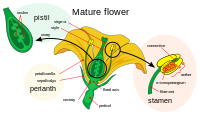
Photo from wikipedia
BackgroundTaihangia rupestris, an andromonoecious plant species, bears both male and hermaphroditic flowers within the same individual. However, the establishment and development of male and hermaphroditic flowers in andromonoecious Taihangia remain… Click to show full abstract
BackgroundTaihangia rupestris, an andromonoecious plant species, bears both male and hermaphroditic flowers within the same individual. However, the establishment and development of male and hermaphroditic flowers in andromonoecious Taihangia remain poorly understood, due to the limited genetic and sequence information. To investigate the potential molecular mechanism in the regulation of Taihangia flower formation, we used de novo RNA sequencing to compare the transcriptome profiles of male and hermaphroditic flowers at early and late developmental stages.ResultsFour cDNA libraries, including male floral bud, hermaphroditic floral bud, male flower, and hermaphroditic flower, were constructed and sequenced by using the Illumina RNA-Seq method. Totally, 84,596,426 qualified Illumina reads were obtained and then assembled into 59,064 unigenes, of which 24,753 unigenes were annotated in the NCBI non-redundant protein database. In addition, 12,214, 7,153, and 8,115 unigenes were assigned into 53 Gene Ontology (GO) functional groups, 25 Clusters of Orthologous Group (COG) categories, and 126 Kyoto Encyclopedia of Genes and Genomes (KEGG) pathways, respectively. By pairwise comparison of unigene abundance between the samples, we identified 1,668 differential expressed genes (DEGs), including 176 transcription factors (TFs) between the male and hermaphroditic flowers. At the early developmental stage, we found 263 up-regulated genes and 436 down-regulated genes expressed in hermaphroditic floral buds, while 844 up-regulated genes and 314 down-regulated genes were detected in hermaphroditic flowers at the late developmental stage. GO and KEGG enrichment analyses showed that a large number of DEGs were associated with a wide range of functions, including cell cycle, epigenetic processes, flower development, and biosynthesis of unsaturated fatty acid pathway. Finally, real-time quantitative PCR was conducted to validate the DEGs identified in the present study.ConclusionIn this study, transcriptome data of this rare andromonoecious Taihangia were reported for the first time. Comparative transcriptome analysis revealed the significant differences in gene expression profiles between male and hermaphroditic flowers at early and late developmental stages. The transcriptome data of Taihangia would be helpful to improve the understanding of the underlying molecular mechanisms in regulation of flower formation and unisexual flower establishment in andromonoecious plants.
Journal Title: BMC Plant Biology
Year Published: 2017
Link to full text (if available)
Share on Social Media: Sign Up to like & get
recommendations!